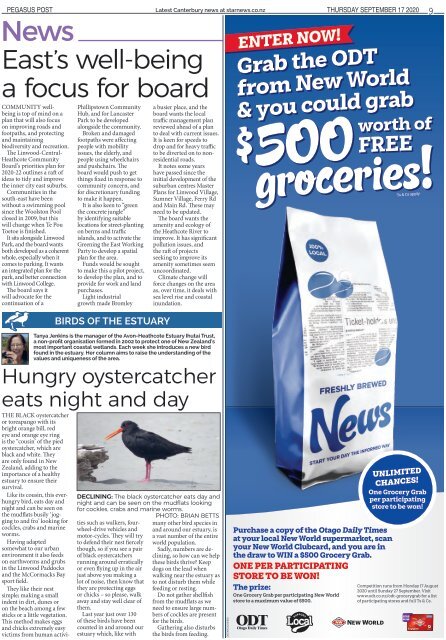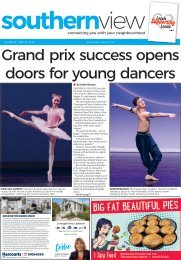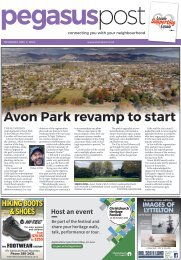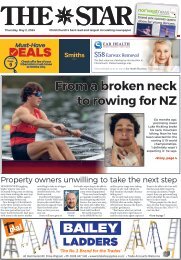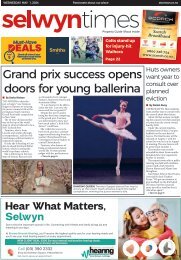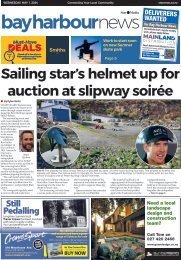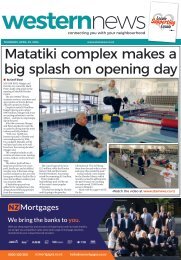Pegasus Post: September 17, 2020
You also want an ePaper? Increase the reach of your titles
YUMPU automatically turns print PDFs into web optimized ePapers that Google loves.
PEGASUS POST Latest Canterbury news at starnews.co.nz<br />
Thursday <strong>September</strong> <strong>17</strong> <strong>2020</strong> 9<br />
News<br />
East’s well-being<br />
a focus for board<br />
COMMUNITY wellbeing<br />
is top of mind on a<br />
plan that will also focus<br />
on improving roads and<br />
footpaths, and protecting<br />
and maintaining<br />
biodiversity and recreation.<br />
The Linwood-Central-<br />
Heathcote Community<br />
Board’s priorities plan for<br />
<strong>2020</strong>-22 outlines a raft of<br />
ideas to tidy and improve<br />
the inner city east suburbs.<br />
Communities in the<br />
south-east have been<br />
without a swimming pool<br />
since the Woolston Pool<br />
closed in 2009, but this<br />
will change when Te Pou<br />
Toetoe is finished.<br />
It sits alongside Linwood<br />
Park, and the board wants<br />
both developed as a coherent<br />
whole, especially when it<br />
comes to parking. It wants<br />
an integrated plan for the<br />
park, and better connection<br />
with Linwood College.<br />
The board says it<br />
will advocate for the<br />
continuation of a<br />
Phillipstown Community<br />
Hub, and for Lancaster<br />
Park to be developed<br />
alongside the community.<br />
Broken and damaged<br />
footpaths were affecting<br />
people with mobility<br />
issues, the elderly, and<br />
people using wheelchairs<br />
and pushchairs. The<br />
board would push to get<br />
things fixed in response to<br />
community concern, and<br />
for discretionary funding<br />
to make it happen.<br />
It is also keen to “green<br />
the concrete jungle”<br />
by identifying suitable<br />
locations for street-planting<br />
on berms and traffic<br />
islands, and to activate the<br />
Greening the East Working<br />
Party to develop a spatial<br />
plan for the area.<br />
Funds would be sought<br />
to make this a pilot project,<br />
to develop the plan, and to<br />
provide for work and land<br />
purchases.<br />
Light industrial<br />
growth made Bromley<br />
a busier place, and the<br />
board wants the local<br />
traffic management plan<br />
reviewed ahead of a plan<br />
to deal with current issues.<br />
It is keen for speeds to<br />
drop and for heavy traffic<br />
to be diverted on to nonresidential<br />
roads.<br />
It notes some years<br />
have passed since the<br />
initial development of the<br />
suburban centres Master<br />
Plans for Linwood Village,<br />
Sumner Village, Ferry Rd<br />
and Main Rd. These may<br />
need to be updated.<br />
The board wants the<br />
amenity and ecology of<br />
the Heathcote River to<br />
improve. It has significant<br />
pollution issues, and<br />
the raft of projects<br />
seeking to improve its<br />
amenity sometimes seem<br />
uncoordinated.<br />
Climate change will<br />
force changes on the area<br />
as, over time, it deals with<br />
sea level rise and coastal<br />
inundation.<br />
BIRDS OF THE ESTUARY<br />
Tanya Jenkins is the manager of the Avon-Heathcote Estuary Ihutai Trust,<br />
a non-profit organisation formed in 2002 to protect one of New Zealand’s<br />
most important coastal wetlands. Each week she introduces a new bird<br />
found in the estuary. Her column aims to raise the understanding of the<br />
values and uniqueness of the area.<br />
Hungry oystercatcher<br />
eats night and day<br />
DECLINING: The black oystercatcher eats day and<br />
night and can be seen on the mudflats looking<br />
for cockles, crabs and marine worms.<br />
THE BLACK oystercatcher<br />
or toreapango with its<br />
bright orange bill, red<br />
eye and orange eye ring<br />
is the “cousin’ of the pied<br />
oystercatcher, which are<br />
black and white. They<br />
are only found in New<br />
Zealand, adding to the<br />
importance of a healthy<br />
estuary to ensure their<br />
survival.<br />
Like its cousin, this everhungry<br />
bird, eats day and<br />
night and can be seen on<br />
the mudflats busily ‘jogging<br />
to and fro’ looking for<br />
cockles, crabs and marine<br />
worms.<br />
Having adapted<br />
somewhat to our urban<br />
environment it also feeds<br />
on earthworms and grubs<br />
in the Linwood Paddocks<br />
and the McCormacks Bay<br />
sport field.<br />
They like their nest<br />
simple; making a small<br />
indent in dirt, dunes or<br />
on the beach among a few<br />
sticks or a little vegetation.<br />
This method makes eggs<br />
and chicks extremely easy<br />
victims from human activities<br />
such as walkers, fourwheel-drive<br />
vehicles and<br />
motor-cycles. They will try<br />
to defend their nest fiercely<br />
though, so if you see a pair<br />
of black oystercatchers<br />
running around erratically<br />
or even flying up in the air<br />
just above you making a<br />
lot of noise, then know that<br />
they are protecting eggs<br />
or chicks – so please, walk<br />
away and stay well clear of<br />
them.<br />
Last year just over 130<br />
of these birds have been<br />
counted in and around our<br />
estuary which, like with<br />
PHOTO: BRIAN BETTS <br />
many other bird species in<br />
and around our estuary, is<br />
a vast number of the entire<br />
world population.<br />
Sadly, numbers are declining,<br />
so how can we help<br />
these birds thrive? Keep<br />
dogs on the lead when<br />
walking near the estuary as<br />
to not disturb them while<br />
feeding or resting.<br />
Do not gather shellfish<br />
from the mudflats as we<br />
need to ensure large numbers<br />
of cockles are present<br />
for the birds.<br />
Gathering also disturbs<br />
the birds from feeding.


